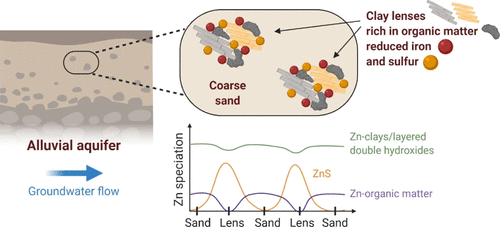当前位置:
X-MOL 学术
›
Environ. Sci. Technol.
›
论文详情
Our official English website, www.x-mol.net, welcomes your
feedback! (Note: you will need to create a separate account there.)
Simulated Aquifer Heterogeneity Leads to Enhanced Attenuation and Multiple Retention Processes of Zinc
Environmental Science & Technology ( IF 10.8 ) Pub Date : 2021-02-11 , DOI: 10.1021/acs.est.0c06750 Maya Engel 1, 2 , Kristin Boye 2 , Vincent Noël 2 , Tristan Babey 1, 2 , John R. Bargar 2 , Scott Fendorf 1
Environmental Science & Technology ( IF 10.8 ) Pub Date : 2021-02-11 , DOI: 10.1021/acs.est.0c06750 Maya Engel 1, 2 , Kristin Boye 2 , Vincent Noël 2 , Tristan Babey 1, 2 , John R. Bargar 2 , Scott Fendorf 1
Affiliation

|
Alluvial aquifers serve as one of the main water sources for domestic, agricultural, and industrial purposes globally. Groundwater quality, however, can be threatened by naturally occurring and anthropogenic metal contaminants. Differing hydrologic and biogeochemical conditions between predominantly coarse-grained aquifer sediments and embedded layers or lenses of fine-grained materials lead to variation in metal behavior. Here, we examine processes controlling Zn partitioning within a dual-pore domain-reconstructed alluvial aquifer. Natural coarse aquifer sediments from the Wind River−Little Wind River floodplain near Riverton, WY, were used in columns with or without fine-grained lenses to examine biogeochemical controls on Zn concentrations, retention mechanisms, and transport. Following the introduction of Zn to the groundwater source, Zn preferentially accumulated in the fine-grained lenses, despite their small volumetric contributions. While the clay fraction dominated Zn retention in the sandy aquifer, the lenses supported additional reaction pathways of retention—the reducing conditions within the lenses resulted in ZnS precipitation, overriding the contribution of organic matter. Zinc concentration in the groundwater controlled the formation of Zn-clays and Zn-layered double hydroxides, whereas the extent of sulfide production controlled precipitation of ZnS. Our findings illustrate how both spatial and compositional heterogeneities govern the extent and mechanisms of Zn retention in intricate groundwater systems, with implications for plume behavior and groundwater quality.
中文翻译:

模拟的含水层非均质性导致增强的锌衰减和多重保留过程
冲积层是全球家庭,农业和工业用途的主要水源之一。但是,天然存在的和人为的金属污染物可能会威胁到地下水的质量。主要是粗粒含水层沉积物和细粒物质的埋入层或透镜之间的水文和生物地球化学条件不同,会导致金属行为的变化。在这里,我们检查控制双孔域重构冲积含水层中Zn分区的过程。来自怀俄明州里弗顿附近的风河-小风河漫滩的天然粗含水层沉积物被用于装有或不装有细粒透镜的色谱柱中,以研究对锌浓度,保留机制和迁移的生物地球化学控制。在将Zn引入地下水源之后,尽管体积贡献很小,但Zn仍优先积累在细晶状镜片中。尽管粘土成分占砂质含水层中Zn保留的主要部分,但晶状体却支持了附加的保留反应路径-晶状体内的还原条件导致ZnS沉淀,从而超过了有机物的贡献。地下水中的锌浓度控制着锌粘土和锌层状双氢氧化物的形成,而硫化物的产生程度控制了锌的沉淀。我们的研究结果说明了空间和成分的异质性如何控制复杂地下水系统中锌保留的程度和机理,并对羽流行为和地下水质量产生了影响。尽管粘土成分占砂质含水层中Zn保留的主要部分,但晶状体却支持了附加的保留反应路径-晶状体内的还原条件导致ZnS沉淀,从而超过了有机物的贡献。地下水中的锌浓度控制着锌粘土和锌层状双氢氧化物的形成,而硫化物的产生程度控制了锌的沉淀。我们的研究结果说明了空间和成分的异质性如何控制复杂地下水系统中锌保留的程度和机理,并对羽流行为和地下水质量产生了影响。尽管粘土成分占砂质含水层中Zn保留的主要部分,但晶状体却支持了附加的保留反应路径-晶状体内的还原条件导致ZnS沉淀,从而超过了有机物的贡献。地下水中的锌浓度控制着锌粘土和锌层状双氢氧化物的形成,而硫化物的产生程度控制了锌的沉淀。我们的研究结果说明了空间和成分的异质性如何控制复杂地下水系统中锌保留的程度和机理,并对羽流行为和地下水质量产生了影响。超越有机物的贡献。地下水中的锌浓度控制着锌粘土和锌层状双氢氧化物的形成,而硫化物的产生程度控制了锌的沉淀。我们的研究结果说明了空间和成分的异质性如何控制复杂地下水系统中锌保留的程度和机理,并对羽流行为和地下水质量产生了影响。超越有机物的贡献。地下水中的锌浓度控制着锌粘土和锌层状双氢氧化物的形成,而硫化物的产生程度控制了锌的沉淀。我们的研究结果说明了空间和成分的异质性如何控制复杂地下水系统中锌保留的程度和机理,并对羽流行为和地下水质量产生了影响。
更新日期:2021-03-02
中文翻译:

模拟的含水层非均质性导致增强的锌衰减和多重保留过程
冲积层是全球家庭,农业和工业用途的主要水源之一。但是,天然存在的和人为的金属污染物可能会威胁到地下水的质量。主要是粗粒含水层沉积物和细粒物质的埋入层或透镜之间的水文和生物地球化学条件不同,会导致金属行为的变化。在这里,我们检查控制双孔域重构冲积含水层中Zn分区的过程。来自怀俄明州里弗顿附近的风河-小风河漫滩的天然粗含水层沉积物被用于装有或不装有细粒透镜的色谱柱中,以研究对锌浓度,保留机制和迁移的生物地球化学控制。在将Zn引入地下水源之后,尽管体积贡献很小,但Zn仍优先积累在细晶状镜片中。尽管粘土成分占砂质含水层中Zn保留的主要部分,但晶状体却支持了附加的保留反应路径-晶状体内的还原条件导致ZnS沉淀,从而超过了有机物的贡献。地下水中的锌浓度控制着锌粘土和锌层状双氢氧化物的形成,而硫化物的产生程度控制了锌的沉淀。我们的研究结果说明了空间和成分的异质性如何控制复杂地下水系统中锌保留的程度和机理,并对羽流行为和地下水质量产生了影响。尽管粘土成分占砂质含水层中Zn保留的主要部分,但晶状体却支持了附加的保留反应路径-晶状体内的还原条件导致ZnS沉淀,从而超过了有机物的贡献。地下水中的锌浓度控制着锌粘土和锌层状双氢氧化物的形成,而硫化物的产生程度控制了锌的沉淀。我们的研究结果说明了空间和成分的异质性如何控制复杂地下水系统中锌保留的程度和机理,并对羽流行为和地下水质量产生了影响。尽管粘土成分占砂质含水层中Zn保留的主要部分,但晶状体却支持了附加的保留反应路径-晶状体内的还原条件导致ZnS沉淀,从而超过了有机物的贡献。地下水中的锌浓度控制着锌粘土和锌层状双氢氧化物的形成,而硫化物的产生程度控制了锌的沉淀。我们的研究结果说明了空间和成分的异质性如何控制复杂地下水系统中锌保留的程度和机理,并对羽流行为和地下水质量产生了影响。超越有机物的贡献。地下水中的锌浓度控制着锌粘土和锌层状双氢氧化物的形成,而硫化物的产生程度控制了锌的沉淀。我们的研究结果说明了空间和成分的异质性如何控制复杂地下水系统中锌保留的程度和机理,并对羽流行为和地下水质量产生了影响。超越有机物的贡献。地下水中的锌浓度控制着锌粘土和锌层状双氢氧化物的形成,而硫化物的产生程度控制了锌的沉淀。我们的研究结果说明了空间和成分的异质性如何控制复杂地下水系统中锌保留的程度和机理,并对羽流行为和地下水质量产生了影响。











































 京公网安备 11010802027423号
京公网安备 11010802027423号